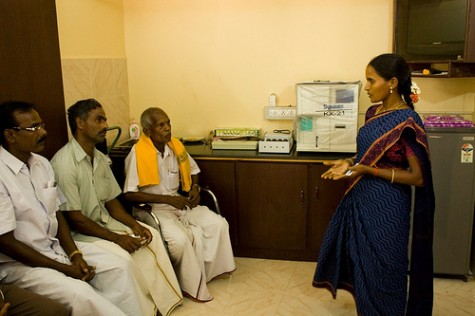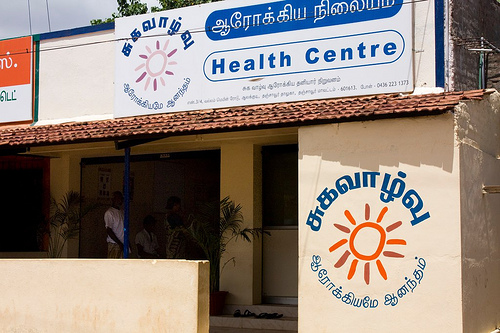Advancing Healthcare: Reaching Into Rural Pockets With A Sustainable Model
Editor’s Note: This is the first of several blog posts for NextBillion’s Advancing Healthcare with the BoP series.
In recent decades, the public sector has had fair success in improving health in developing countries. As a result, infant, child and maternal mortality have declined; the threat of infectious disease has receded; and life expectancy has increased in all developing regions. Yet, working in isolation, the public sector faces significant implementation and resource problems. More specifically, government-run health programs face particular challenges in accessing geographically isolated or otherwise difficult-to-reach populations, in furnishing sufficient oversight of program administration to avoid corruption, and in ensuring health subsidies are directed to people who most need them, such as low-income households.
As a result of these resource constraints and under-performance issues in government-run programs, a high proportion of health care models, first innovated in developing countries, now are being realized and delivered by private providers that charge fees for their services. One such model is the Rural Micro Health Centre (RMHC), which is an innovative nurse-managed, doctor-supervised-clinic (NMDSC) being promoted by the IKP Center for Technologies in Public Health (ICTPH) and SughaVazhvu Healthcare in Tamil Nadu.
The goal of the ICTPH – Sughavazhvu Healthcare led RMHC model is to extend access of high-quality, low-cost primary healthcare services to low-income households living in remote rural India and who cannot access existing healthcare systems. This goal crystallized when qualitative and quantitative research conducted in remote rural pockets of India assessed health-seeking behaviours and needs. This research also revealed that low-income households spent a larger proportion of their income on health care than those with higher incomes. A large percentage of these expenses usually go to either a) paying high interest rates on health care loans; and / or, b) absorbing cost related to travel and lost work time.

(Above, a doctor shares her experience working in a Sughavazhvu clinic. Image courtesy of ICTPH)
The ICTPH-Sughavazhvu Healthcare model tries to address these issues through a community-based technology-leveraged outreach intervention at the village level. In this model, the RMHC is managed by a local full-time graduate nurse, and supported by 13 locally hired and trained community health workers who are full-time volunteer workers. These workers are reimbursed all their costs and paid a nominal honorarium. While the nurse is responsible for the well-being of about 2,200 households, each community health worker serves 200 households (or approximately 1,000 individuals) and manages the screening, follow-up, intervention implementation and clinical assistance.
Analyzing the RMHC model, it becomes clear that there are four interrelated design components that seem critical to the successful realization of this innovative model that is India’s first attempt to deliver managed healthcare for remote rural Indian populations through intensively organizing primary health care delivery. These design components are as follows: (1) human resource design; (2) infrastructure design; (3) intervention design and, (4) financing design.
As part of the first, the rigorous selection process of the community health workers ensures an optimal skill set; also, an 85 percent time allocation towards field based activities and 15 percent towards clinical assistance at the RMHC, under the supervision of the nurse, allows for the proper development of the competencies of the community health worker.
As part of the second, each RMHC is equipped with tools to deliver a) diagnostics (through auto-analyzers that facilitates hematology and blood biochemistry); b) ophthalmic interventions (refractive errors and cataract management both pre- and post-operative); c) strip tests (pregnancy, urine analysis and malaria); d) automatic prescription (through a web based electronic health record combined with a computer based decision support system); and, e) pharmacy intervention (a drug distribution licence for Sughavazhvu Healthcare enables the RHMC to stock medicines necessary to fill basic prescriptions recommended by the nurse/doctor).

(Above: A Rural Micro Health Center).
As part of the third design, curative interventions envisioned at the RMHC are standardized evidence-based primary care curative protocols, based on the SOAP (Subjective Objective Assessment Plan) methodology, evolved in partnership with the School of Nursing at the University of Pennsylvania. A Health Management Information System (HMIS) helps implement the SOAP methodology for primary care visit, as well as facilitates the supply chain management of drugs from a centralized drug centre. The HMIS is also used by the nurse at the RMHC to ensure rational drug usage through strict compliance of National Essential Drug Guidelines. Lastly, the HMIS also is used for medical insurance, patient referral and follow-care management.
Finally, in order to address patient-financing deficiencies in the system, the RMHC is planning to roll out many financial interventions that show promise of shrinking the deficit between low income households’ ability to pay and the cost of primary health care. These interventions, along with other indirect non-health means, will need to be deployed if the low-income households are to successfully access all the primary health care they need.
The for-profit private sector is a major player in the health care arena in nearly all countries. Individuals- both rich and low-income households – are willing to pay for many health services, which stimulates private provision of health care. As in any market, there is competition based on price, and there may also be competition based on quality or other characteristics of providers. And for market-based healthcare model targeted at low income households to succeed, it is imperative that quality remain high and costs are kept low as possible. Models such as the ICTPH-Sughavazhvu Healthcare led RMHC are out there trying to do exactly that. They’re innovating, and in the process, bringing forward solutions to satisfy human needs profitably and creating wealth for the company and the community it serves!
- Categories
- Uncategorized
